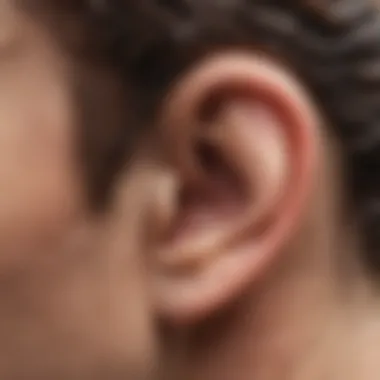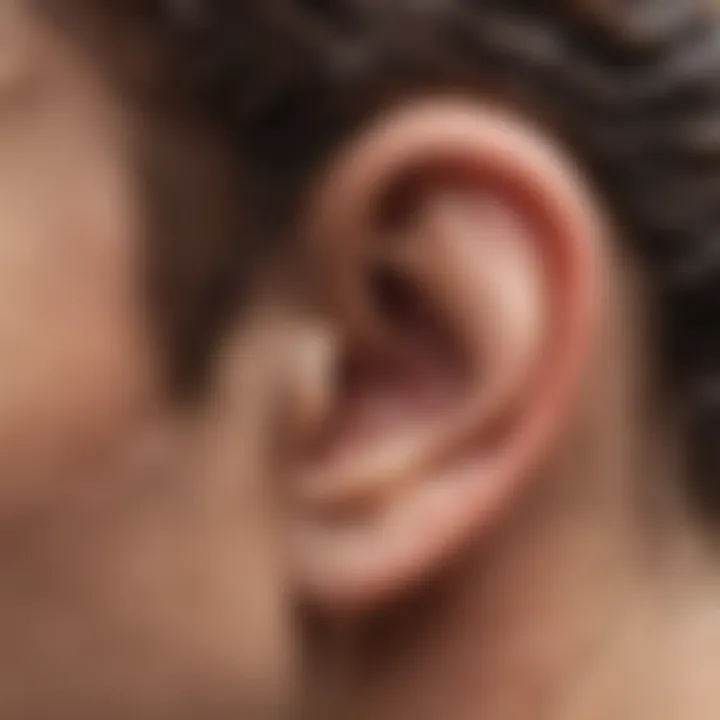Effective Methods to Remove Water from Your Ear


Intro
Water trapped in your ear can feel like an unwelcome guest that just won’t leave. It's more than just an annoyance; for those who dive into watersports, it can become a real headache. Knowing how to effectively deal with this issue is essential for athletes, outdoor buffs, and even the casual swimmer. You might be wondering, what really causes this blockage in the ear? More importantly, what are the most effective ways to tackle it? This article aims to navigate the ups and downs of water retention in the ears, providing you with practical approaches and techniques, while also throwing light on prevention strategies that can keep the hassle at bay.
Gear Recommendations
Essential Gear for Beginners
As a newcomer to the watery world, having the right gear can make your experience so much smoother. While you might not be ready to invest in high-end equipment just yet, certain items can significantly reduce the chances of water getting stuck in your ears.
- Earplugs: Look for those designed specifically for swimming. They create a seal that helps keep water out.
- Swim Caps: A snug swim cap not only keeps your hair dry but also minimizes water entry into your ears.
- Nose Clips: While these don’t directly prevent water in your ears, they can help you stay dry overall.
These items make it easier to enjoy the splashes without worrying too much about post-swim ear woes.
Advanced Equipment for Professionals
For seasoned watersports enthusiasts, it’s advisable to elevate your gear game. Investing in more advanced accessories can optimize both your performance and ear health. Here’s what you might consider:
- Custom-Fit Earplugs: Tailored to your ear shape, these offer an unmatched fit and protection against water entry.
- Drainage Devices: Some new technologies on the market help to actively siphon water from your ear with gentle suction.
- Hoods or Neoprene Caps: In cold water environments, a hood can prevent water from entering the ear while also providing warmth.
Each piece of gear serves a distinct purpose in keeping water out of your ears and improving your overall aquatic experience.
Techniques and Tips
Skill Improvement Strategies
Engaging in activities like swimming, surfing, or diving demands a level of skill that goes hand in hand with ear care. Improving your water skills can greatly reduce water accumulation.
- Practice proper entry techniques: When diving or jumping into water, avoid creating excessive splash to minimize water entry into your ears.
- Learn to Equalize: Mastering techniques for equalizing pressure can not only help in deeper waters but also minimize water retention.
Being aware of how you move in and out of the water can make a significant difference.
Safety Practices and Guidelines
It’s not just about removing the water; it’s also important to have guidelines to prevent any potential risks associated with stagnant water in the ear.
- Avoid Q-tips: Poking around in your ear can push water further in and cause damage.
- Dry Off Smartly: Use a towel to gently dry around your ear after swimming, and tilt your head to let gravity do its job.
- Stay in tune with your body: If you feel pressure or pain lingering, consult a healthcare professional.
Remember, prevention is always better than cure. Taking a few smart steps can keep the discomfort of water-logged ears far from your day under the sun.
By integrating these techniques and tips into your watersport routine, you can better manage the frustration of water in your ear. The journey from a casual swimmer to a confident water athlete doesn't need to be marred by the discomfort of blocked ears. With the right knowledge and precautions, you can enjoy the water without the worries.
Understanding Ear Anatomy
An awareness of ear anatomy isn’t merely academic; it’s central to grasping why water can linger in the ear after activities like swimming or bathing. Recognizing the layout of this complex organ aids in understanding the complications that can arise when water becomes trapped. This section lays the groundwork for appreciating the practical approaches for removal and can spark a curiosity about ear health overall.
The Structure of the Ear
The ear comprises three main sections: the outer ear, the middle ear, and the inner ear. Each part serves a distinct purpose, contributing to the overall function of hearing and balance.
- Outer Ear: This visible portion consists of the pinna and the ear canal. The pinna funnels sound waves toward the ear canal, making it essential for capturing sound.
- Middle Ear: The air-filled cavity behind the eardrum contains the three tiny bones called ossicles - the malleus, incus, and stapes. These bones amplify sound vibrations from the eardrum and transmit them to the inner ear.
- Inner Ear: This section houses the cochlea and vestibular system, both crucial for hearing and balance, respectively. The cochlea converts sound vibrations into electrical signals which the brain interprets as sound.
A deep understanding of these structures sheds light on why someone might experience discomfort when water remains trapped after a swim. Understanding where water can enter and become stuck will enable better application of practical advice provided in later sections.
How the Ear Drains Water
The ear's drainage mechanism is quite ingenious and works primarily through gravity and natural air pressure changes. Here’s how it typically happens:
- Design of the Ear Canal: The ear canal is largely angled downwards, which naturally allows some water to drain out over time. However, if water is trapped, it can create discomfort and even lead to infections.
- Eustachian Tube Function: The Eustachian tubes connect the middle ear to the throat. They help equalize pressure and can also aid in clearing water when they function well. When we swallow or yawn, these tubes open, promoting fluid drainage.
Understanding these dynamics is critical. If water gets trapped due to issues like an abnormally shaped ear canal or swollen Eustachian tubes, realizing how these factors play into ear health can guide the implementation of remedies or when to seek professional help.
"An informed athlete can often address minor issues before they escalate into troublesome conditions."
In summary, a robust comprehension of ear anatomy is not just useful knowledge; it empowers athletes and water enthusiasts to be proactive in managing potential ear-related problems, ultimately improving their enjoyment and performance in water activities.
Causes of Water Trapping
Understanding why water becomes trapped in your ear is essential. It offers insight not just into the annoyance that stems from this problem but also helps identify proactive measures one can take to avoid such situations altogether. The causes range from specific activities to bodily responses, making it a multifaceted issue. Knowing these elements can guide you to adjust your behaviors and, as a result, minimize future experiences with trapped water.
Swimming and Watersports


Engaging in swimming or watersports is perhaps the most common cause of water entering the ear. When you dive or jump into water, the pressure can push it into your ear canal. This often happens without an individual noticing.
- Water Entry: The direct splashes while swimming in pools or oceans can lead to a noticeable water presence in the ears. Many athletes encounter this phenomenon on a regular basis.
- Wetsuits and Headgear: For those who use wetsuits, the snug fit can sometimes create an unintended seal—allowing water to infiltrate when you surface.
A notable observation from water sports enthusiasts is that certain styles of swimming, like a cannonball or diving headfirst, dramatically increase the risk of getting water trapped. It’s crucial to use ear plugs designed for water sports if you're frequently in the water.
Showering and Bathing
Many people do not realize that simple daily activities, such as showering or bathing, can lead to water retention in the ear. Warm water and steam create a conducive environment for potential trapping. In fact, the ear can easily become a receptacle for water, especially if you lean your head forward while washing your hair.
- Head Positioning: Tilting your head back while rinsing can help minimize water entry, but it may not always be possible to avoid it entirely.
- Over-enthusiastic Cleaning: Using running water directly into your ears while cleaning can certainly amplify the risk of water getting stuck.
Earwax and Blockages
Sometimes, the very substance your body produces to protect your ears—earwax—can paradoxically lead to water retention. When there’s an excessive buildup of earwax, it may form a barrier that traps water inside the ear canal.
- Impact of Excessive Wax: The network of earwax can prevent water from naturally draining out. This often results in discomfort that’s hard to ignore.
- Other Blockages: Certain anatomical conditions, such as unusually shaped ear canals, can also contribute to water becoming trapped. This can be quite frustrating, especially for individuals prone to frequent blockages.
"Understanding these causes can empower individuals. Instead of merely reacting to water, we can anticipate and avoid it."
Recognizing the underlying reasons for water entrapment not only helps in effectively addressing the current predicament but also enables early intervention and prevention strategies going forward.
Symptoms of Water in the Ear
Understanding the symptoms that accompany water trapping in the ear is crucial for anyone who enjoys aquatic activities. As trivial as it might seem, the effects can significantly impact daily life, particularly for athletes, outdoor enthusiasts, and even casual swimmers. Recognizing these symptoms not only aids in effective troubleshooting but also underscores the importance of addressing ear discomfort promptly to avoid complications.
General Discomfort
One of the first signs you may notice when water gets trapped in your ear is a vague sense of general discomfort. This sensation can be akin to having something foreign lodged in your ear canal, which might lead to feelings of pressure or mild irritation. It often feels like a heavy sensation, almost like an uninvited guest lingering way too long.
For those who partake in sports or adventurous activities, such discomfort can be distracting. You might find it hard to concentrate, affecting both athletic performance and enjoyment. It’s like trying to run a marathon while wearing shoes that are just a size too small; it takes a toll on your focus and drives your annoyance up.
Hearing Impairment
Another significant symptom to be mindful of is a temporary reduction in hearing ability. Water in the ear can create a muffled sound experience, as if you're trying to listen through a thick wall. This auditory blockage isn’t just an inconvenience; for those heavily involved in sports like swimming or diving, it could pose safety risks. Hear that blaring whistle from the coach or the subtle chirping of warning calls? Losing even a moment of that crucial auditory information could affect timing and situational awareness.
If you find yourself in a situation where you are missing sounds or it feels like you're in a bubble, this may be an indicator that it’s time to take measures to remove the trapped water. Knowing when to react to such symptoms can make all the difference in ensuring safety and performance in any activity.
Tinnitus Experiences
Lastly, many individuals report experiences of tinnitus when dealing with water trapped in the ears. Tinnitus refers to sensations of ringing, buzzing, or hissing sounds in the ear. It's not just an annoyance; it’s often a signal that something is amiss. Living with constant sounds that aren't there can be disorienting, resulting in stress or anxiety, especially for those who rely on acute auditory perception in their sports.
While it might seem like a minor inconvenience, anyone who has faced this reality knows it takes a toll over time. This kind of experience can tend to amplify once the water remains in the ear for a prolonged period, possibly leading to escalating issues. Therefore, understanding these symptoms and addressing them swiftly can help maintain both your well-being and sport efficiency.
It's clear that recognizing the signs of water trapped in the ear plays a vital role in the health of athletes and those engaging in outdoor activities.
While it may sometimes feel like a minor problem, awareness of these three symptoms can enhance management strategies. Proactive approaches will not only help in relieving discomfort but also promote a smoother experience in any aquatic setting.
Home Remedies for Water Removal
Encountering water stuck in the ear can be quite bothersome, and many people turn to home remedies before seeking professional help. This section focuses on simple yet effective tactics for removing that stubborn water, emphasizing the benefits of natural approaches. Home remedies often use items readily available at home, making them both accessible and cost-effective. However, it’s essential to remember that not every method works for everyone, so a bit of trial and error might be necessary to find what suits you best.
Gravity Techniques
Tilting the Head
One of the most straightforward methods to get water out of your ear is simply tilting the head. This technique lets gravity do much of the work. When you tilt your head towards the affected ear, it can help the water trickle out of the ear canal. It’s an easy, low-effort technique that many swear by.
A key characteristic of this method is its practicality. All you need is a few minutes and a space to lean. However, its effectiveness might depend on several factors, like how much water is trapped and your individual ear anatomy. A unique feature of tilting the head is that it doesn’t involve anything other than patience, which can be quite an advantage for those who prefer simple solutions.
One disadvantage, yet to be considered, is that it might not be enough in cases where water is really lodged deep down. Someone might find themselves needing other interventions as well.
Creating a Vacuum
Another interesting approach to removing water from your ear is to create a vacuum by gently pulling on the earlobe while tilting your head. This technique might sound unusual, but it leverages basic physics principles. When done correctly, the vacuum effect can help dislodge and pull the trapped water out.
The main advantage of this method is that it can be more effective than just tilting the head by itself. The suction created can help if the water is not responding to gravity alone. However, it’s vital to be cautious not to pull too hard; the ear's structure is delicate, after all.
While this method has its upsides, it also has some downsides. Not everyone finds it comfortable, and excessive pulling could create tension rather than relief.
Using Heat Application
Heating Pads


Heating pads can be another great addition to your DIY toolkit for ear discomfort. The warmth helps to encourage the water to evaporate or be released from the ear canal, easing the overall pressure. It’s a comforting method that many people find soothing, providing a gentle way to nudge that stubborn water along.
The practical benefit of using heating pads is that they not only help relieve the trapped water but can also provide a warm sensation that eases any discomfort you might be feeling. By introducing heat to the area, it relaxes the muscles surrounding the ear canal, which can help in release. Be sure to monitor the temperature to avoid burns, which is a clear disadvantage to be mindful of.
Warm Compresses
Similar to heating pads, warm compresses are another easy home remedy that can be effective. A warm, moist cloth placed against the ear can work wonders, again promoting relaxation and potentially easing the removal of water. This gentle method can be pretty handy for people who prefer something non-invasive.
A significant aspect of warm compresses is their versatility—they can be made from items commonly found in households, like hand towels or washcloths soaked in warm water.
However, unlike heating pads that maintain constant warmth, warm compresses may require frequent re-soaking to maintain effectiveness. Additionally, some individuals might find the moisture itself a bit uncomfortable, thus presenting a minor drawback to this method.
Alcohol and Vinegar Mixture
An alcohol and vinegar mixture is another remedy people use. The combination of these two ingredients can help dry out the ear canal, effectively drawing out moisture. Alcohol acts quickly as a drying agent, while vinegar can help restore the ear’s natural pH balance.
This remedy stands out because it’s not only about removing water but also ensuring the ear environment is conducive to healing and protection from infections. It’s been a popular choice for many outdoor enthusiasts who find themselves dealing with waterlogged ears from various activities.
However, one must be cautious with this method. If there's a risk of a ruptured eardrum or any existing ear conditions, alcohol and vinegar might irritate the ear further. Consulting with a healthcare professional before trying this remedy is wise to avoid any potential mishaps.
"It's always better to be safe than sorry, especially when it comes to our health."
In summary, these home remedies can provide relief and are a great first line of defense against water trapped in the ear. While they may not work magic in every case, they offer various tools for individuals to address their discomfort at home.
Over-the-Counter Solutions
When water gets trapped in the ear, it can be a real nuisance, especially for individuals who relish aquatic adventures like swimming or surfing. Fortunately, there are several over-the-counter solutions available that can assist in alleviating this discomfort. These products not only aim to remove the water but also help prevent further issues, such as infections or prolonged discomfort. Addressing this topic is crucial as it offers practical, straightforward ways to manage an issue that's all too common in the active lifestyle of athletes, outdoor enthusiasts, and even casual swimmers.
A careful selection of over-the-counter remedies is important as they are easily accessible and designed to be user-friendly, minimizing the need for medical intervention in most cases. However, understanding the ingredients and their purpose can make a significant difference in effectiveness.
Ear Drops for Water Removal
Ear drops specifically designed for water removal typically contain a mix of isopropyl alcohol and glycerin. The alcohol serves to evaporate trapped water, while glycerin protects the fragile ear canal from irritation. This twofold approach can provide quick relief from that blocked sensation.
To use these drops effectively, follow the instructions on the label closely. Generally, you will:
- Lie down on your side with the affected ear facing down.
- Administer the drops carefully into the ear canal.
- Stay in that position for a few minutes, allowing the formula to work its magic.
- Sit up and let the liquid drain out, possibly with a gentle shake of the head.
It's wise to choose a reliable brand, and many users recommend products like Swim-Ear or Auro-Dri, both of which are readily available at drugstores and online. Always check for any potential allergens or sensitivities when selecting ear drops, especially if you have had previous reactions to ingredients.
Drying Agents
Apart from ear drops, drying agents are another essential category in the market for those dealing with stubborn water in their ears. These products often come in various forms, including powders, sprays, or liquid solutions. Their purpose is simple: to help absorb moisture trapped in the ear canal.
Benefits of using drying agents include:
- Fast action by reducing excess moisture.
- Ease of use, allowing for a swift application without requiring specialized knowledge.
- Variety of options, enabling you to choose based on personal preference and comfort.
For example, some drying agents contain various alcohol components, while others might use non-irritating formulas suitable for sensitive skin. Popular choices include the aforementioned Swim-Ear or ear-drying products from brands like Debrox. Always remember to read the labels for recommended dosages and any specific instructions to avoid complications.
When to Seek Medical Attention
Navigating through the discomfort of water trapped in your ear can indeed be a hassle. Most of the time, a few home remedies or over-the-counter solutions can do the trick. However, there are instances where seeking medical attention becomes crucial. Recognizing when to make that call is essential for your health and peace of mind.
While initial symptoms might seem mild, persistent issues can lead to more serious concerns. Water trapped in the ear can evolve from a simple nuisance to a breeding ground for infections. Being vigilant about your symptoms is key for proper management. Additionally, if symptoms linger, it's often a sign that your body needs professional intervention. Ignoring such signs could result in complex issues later on.
Here are few considerations when thinking about reaching out to a healthcare provider:
- Assessment: A professional can accurately assess whether it’s an infection or simply retained moisture.
- Ear Health: They can provide insights on the condition of your ear canal and eardrum.
- Treatment Options: If infections are at play, a healthcare provider can prescribe appropriate medications.
"Knowing when to seek medical help isn’t just about science; it’s about listening to your body."
Persistent Symptoms
Persistent symptoms can be your body’s way of waving a red flag. After a bout of water exposure—be it swimming, showering, or just a rainy day—if the feeling of fullness in your ear hangs around longer than a day or two, it’s worth taking note. Some common persistent symptoms include:
- Continued Discomfort: A nagging feeling of pressure or fullness that doesn’t seem to fade can be disconcerting.
- Hearing Loss: If sounds seem muffled or distorted, this might indicate that your ear is still filled with fluid.
- Inner Ear Symptoms: Balance issues or dizziness may arise if the inner ear is affected.
If you observe these symptoms persisting beyond a few days, it’s wise to contact a healthcare professional. They can provide you with a proper evaluation and individualized care.
Signs of Infection
Infections can be a nasty side effect of water trapped in the ear. It’s crucial to recognize the signs of an infection, as early detection can save your ear from further complications. Here’s what to look out for:


- Increased Pain: If you’re experiencing a sharp or throbbing pain in your ear, this isn’t a good sign.
- Fever: A rising body temperature can indicate that your body is battling an infection.
- Discharge: If fluid begins to drain from your ear, especially if it's foul-smelling or accompanied by other symptoms.
- Irritated Skin: Redness or swelling around the ear may also suggest an infection developing.
Addressing these signs promptly can help in preventing any escalation and complications, such as potential hearing loss or chronic ear problems. It’s not just about the immediate discomfort; it’s about maintaining long-term ear health.
Prevention Strategies
Preventing water from getting lodged in your ear can save you a world of hassle and discomfort. When it comes to engaging in activities like swimming, surfing, or even taking a shower, the last thing you want is for water to become trapped in your ear canal. Here, we’ll explore some robust techniques you can adopt to keep your ears dry and healthy.
Ear Protection during Watersports
For those who frequent aquatic environments, investing in specialized ear protection is crucial. Earplugs designed for swimming can effectively seal the ear canal, preventing water from entering. Brands like Mack's AquaBlock or Speedo's silicone earplugs are popular among athletes.
Wearing a swim cap can also add an extra layer of defense, especially when scuba diving or surfing. It creates a barrier that minimizes water exposure to your ears.
Also, consider being aware of the kind of conditions you're swimming in. Rough waters can splash water into your ears more readily, so adjusting your activities to calmer days can be beneficial, or at least it’s worth a thought.
Avoiding Waterlogged Situations
Sometimes, the simplest strategy is to steer clear of any situation that might leave you with water in your ears. For example, when showering, keeping your ears out of the direct spray by tilting your head to the side or using a shower cap can be effective strategies. If you like a convenient way to keep your ears dry while bathing, look into products designed to block moisture.
In addition to that, be conscious while engaging in activities that involve submersion. If you're diving, dip your head just beneath the surface instead of plunging in. This slight alteration minimizes water exposure significantly.
Regular Ear Maintenance
Just like any part of your body, your ears need their own kind of maintenance. Regular cleaning helps to prevent wax buildup, which can trap water. You should not insert anything deep into your ear, though; a soft cloth or the outer ear can be cleaned regularly.
Consider using a saline solution to rinse out ears after swimming or using custom-made ear drops formulated to remove excess moisture.
Also, don’t underestimate the power of a proper drying technique. When you come out of the water, tilting your head and hopping on one foot can be an efficient way to get rid of trapped water. Just a small reminder; don’t use cotton swabs as they can push earwax deeper and create blocks.
"An ounce of prevention is worth a pound of cure."
Staying vigilant about these simple practices can diminish the likelihood of experiencing ear problems related to trapped water. By incorporating preventive measures, you can embrace the water with confidence rather than fear the aftermath.
Exploring Alternative Remedies
The experience of water getting stuck in your ear after a refreshing day in the pool or ocean can be bothersome for many, especially athletes and outdoor lovers. While traditional methods often provide temporary relief, exploring alternative remedies can lead people to better outcomes and enhance their recovery process. These options open the door to natural treatments that may ease discomfort, promote healing, and even prevent future occurrences. So, if you’re stuck in such a bind, keep reading as we delve into a couple of these alternative methods that could make a world of difference.
Essential Oils and Their Applications
Essential oils have gained traction for their wide array of therapeutic properties. Tea tree oil and lavender oil are among the most often touted for their antibacterial and anti-inflammatory benefits. When it comes to using essential oils for trapped water in the ear, a few drops may help alleviate discomfort and potentially reduce the risk of infection. Here’s how you could utilize them:
- Dilution is Key: Always dilute essential oils with a carrier oil like olive or coconut oil before applying. This helps prevent irritation.
- Application Method: Mix a small amount of the diluted tea tree oil, and gently apply it just outside the ear canal, not directly inside—think of it as a perimeter defense rather than a direct assault.
- Follow-Up: Allow the mixture to sit for a few minutes; the warm sensation can aid in loosening the trapped water.
These oils not only help fight potential bacteria but also provide a calming effect on the discomfort that comes with water blockage. However, those with sensitive skin or allergies should approach this remedy with caution and perform a patch test first.
Acupressure Techniques
Using pressure points to relieve discomfort may sound unconventional for some, but it’s a method deeply rooted in ancient practices. Acupressure focuses on stimulating specific points on the body to alleviate issues, and it can be surprisingly effective for water trapped in your ear. Here’s a straightforward guide to get you started:
- Identify Pressure Points: The point called "Gallbladder 2" (located in front of the ear) can be particularly effective. Apply gentle pressure with your fingers for 30 seconds.
- Combine Techniques: Applying pressure while gently pulling on your earlobe may encourage the water to shift, thus relieving the pressure.
- Consistency Matters: These techniques might require a few tries to work effectively. Don’t be discouraged if it doesn’t happen on the first go.
Exploring alternative remedies like essential oils and acupressure techniques can be beneficial for managing stubborn water in your ear. While individual responses to these techniques can vary, they offer a natural and accessible means to enhance your well-being. Whether you’re an athlete heading back to the waves or just someone enjoying a leisurely swim, these remedies provide additional tools in your arsenal to tackle any unwelcome visitors in your ear.
Real-Life Scenarios and Solutions
When trapped water is stubbornly clinging onto your eardrum, it’s more than just an inconvenience. It's a common trial, especially among those who spend time in and around water. This scenario goes beyond theory; real-life experiences echo the struggle, enriching our understanding and leading to practical solutions. Knowing how others have dealt with this issue can provide valuable insights and reassurance that effective remedies exist.
Water retention in the ear can lead to discomfort, impair hearing, and cause unnecessary panic. Real-life scenarios offer relatable accounts that can illuminate possible remedies and coping strategies. By sharing cases, we not only highlight the relevance of methods discussed in the article but also acknowledge that these challenges are faced by many.
Cases from Watersports Enthusiasts
For many outdoor athletes and watersports aficionados, water in the ear tends to happen more than once. Take, for instance, Jordan, a fervent surfer from California. After every surf session, he routinely found himself struggling to shake off trapped water. After trying various methods, he discovered a combination of gravity and heat application worked like a charm.
- Tilting the Head: In his case, tilting the head down toward the shoulder of the affected ear while hopping on one leg was surprisingly effective. This simple movement allowed gravity to do its part, freeing the water trapped in his ear canal.
- Warm Compress: After trying the hopping routine, he realized that applying a warm compress helped loosen any stubborn moisture. The warmth relaxed his ear muscles, allowing for a quick release of trapped water.
Jordan’s experience is not isolated. Many swimmers in competitive settings have similar tales, underscoring the importance of merging intuitive techniques with established remedies.
Diverse Experiences and Outcomes
From Jordan’s practical approach to water removal, let’s not overlook others with unique encounters. For instance, Lisa, a pool instructor, had a different experience. Each time she finished a class, she noticed that water seemed to accumulate more easily. Frustrated, she sought tips online and stumbled upon using a mixture of alcohol and vinegar. This solution intrigued her since it not only helped dislodge water but also dried out the ear canal.
Further exploration reveals a spectrum of solutions:
- Personal Success Stories: Many swimmers on platforms like Reddit have shared stories of success with acupressure techniques. Applying pressure to specific points behind the ear has reportedly encouraged water drainage.
- Wrap Ups and Swaps: Others have found using earplugs before swimming or showering to be a game changer. By preventing water entry altogether, they avoided the problem before it even started.
Throughout these narratives, a common thread surfaces: while each individual may experience distinct paths to relief, their journeys collectively contribute to a rich pool of knowledge. What works for one may not work for another, but sharing these anecdotes is crucial in demystifying persistent ear discomfort.
As this section illustrates, recognizing these real-life scenarios and outcomes not only lends credibility to the methods being discussed, but it also fosters an understanding that persistence often leads to discovery. Whether from camaraderie among water sports enthusiasts or diverse experiences shared online, there’s much to learn in the face of stubborn water in the ear.















